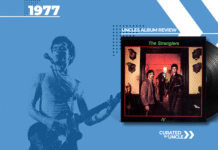Welcome to the Working Class Dreamscape
There’s a strange irony in seeing Born in the U.S.A blaring at political rallies led by people who never bothered to read the lyrics. Released in 1984, Bruce Springsteen’s seventh studio album is a glittering Trojan horse: an arena-rock beast wrapped around a bleak commentary on shattered American ideals. Patriotic on the surface, protest at its heart.
To a 10-year-old me, this was the sound of dad-rock perfection loud, proud and as American as an apple pie laced with regret. Years later, I finally understood the desperation behind the bombast. Bruce wasn’t cheering; he was pleading.
Table of Contents
Who’s Driving the Chevy?
- Bruce Springsteen – vocals, guitar, harmonica and existential dread
- Roy Bittan – keyboards, piano, synthesisers and general sparkle
- Clarence Clemons – saxophone and soul in a suit
- Danny Federici – organ, glockenspiel (yes, glockenspiel)
- Garry Tallent – bass guitar and grounded brilliance
- Max Weinberg – drums, thunder and precise punishment
- Steven Van Zandt – backing vocals and bandana-fuelled rebellion

Themes: American Dream, Meet the American Scream
This isn’t jingoism. It’s the sound of a man waving the flag while watching it burn. The album touches on war, poverty, masculinity, fading youth and love in decay. Bruce’s genius lies in making the personal political and the political sound like a rock show.
Born in the U.S.A is drenched in nostalgia, anger and reluctant patriotism. It’s a love letter to the working class with the envelope soaked in tears.
Track by Track: Blue Jeans, Broken Dreams
1. Born in the U.S.A
That opening synth stab is the musical equivalent of a firework going off inside a factory. Patriotic? Only if you ignore the verses, which detail the story of a Vietnam vet chewed up and spat out by the country he served. The chorus soars while the lyrics weep. It’s a protest anthem dressed in red, white and bruises.
2. Cover Me
Springsteen’s take on a relationship as shelter from the storm. “Cover me, baby, with your arms.” Sounds romantic until you realise it’s more of a plea than a proposition. A driving beat and stabbing guitar riff push this track into danceable darkness. It’s sexy, yes but desperate, too. Like a one-night stand in the middle of a hurricane.
3. Darlington County
A road trip through dead-end dreams. Bruce and a buddy head south in search of work, women, or something resembling hope. It’s got a rollicking, bar-band energy that makes you want to sing along, until you realise the joke’s on them. This is Springsteen’s gift: packaging quiet despair as an all-American party.
4. Working on the Highway
Starts with rockabilly swagger and quickly becomes a dystopian tale of impulsive love, incarceration and picking asphalt in the hot sun. It’s catchy as hell, but again read the lyrics. He meets a girl, elopes, gets caught and winds up literally working on the highway. A metaphor wrapped in a toe-tapper.
5. Downbound Train
Perhaps the most emotionally gutted song on the album. A synth-laced dirge about a man losing his job, his lover and his grip. The train here isn’t just downbound it’s headed straight to heartbreak. Springsteen’s vocals feel hollowed out, echoing with loss. It’s one of his finest portraits of economic and emotional despair.
6. I’m on Fire
Creeping, minimal and intensely haunting. A song that whispers rather than screams. “Hey little girl, is your daddy home?” – yes, it sounds stalker-ish, but it captures longing, lust and loneliness in just a few breathy minutes. Sparse guitar and an eerie synth make it feel like a slow dance at the end of the world.
7. No Surrender
The most youthful-sounding anthem of the bunch. This is Bruce in high school, defiant, scribbling lyrics on notebook margins and refusing to sell out. It’s romanticised nostalgia, yes, but with enough grit to avoid sugar-coating. A big singalong chorus masks a deep yearning to hold onto the ideals that adulthood keeps trying to erase.
8. Bobby Jean
A bittersweet farewell. The song’s open letter to a friend, most believe it’s to Steve Van Zandt – is as touching as anything Bruce ever wrote. “I’m just calling one last time, not to change your mind…” It’s a goodbye without bitterness, full of gratitude and ache. If you’ve ever lost someone to life’s drift, this will hit hard.
9. I’m Goin’ Down
A deceptively upbeat bop about the slow rot of love. The couple’s not screaming, not fighting, they’re just bored. “I’m goin’ down, down, down…” with a grin so wide you forget how sad it is. Springsteen nails the quiet tragedy of relationships that don’t explode they just fizzle, quietly choking on routine.
10. Glory Days
The ultimate ode to peaking too early. A washed-up pitcher, a girl who still talks about high school and Bruce trying not to end up one of them. It’s fun, sure – but tinged with regret. That riff sounds like a smile frozen in time. Glory days, yeah, they pass you by. Fast.
11. Dancing in the Dark
Ironically, the biggest hit was also the most frustrated. “I ain’t nothing but tired… I’m just tired and bored with myself.” The synths sizzle, the beat pops and Bruce sounds like a man dancing to avoid collapse. It’s a cry for reinvention masquerading as a club hit. Also: Courtney Cox in the video. Enough said.
12. My Hometown
The album ends in a whisper. A quiet, heartbreaking portrait of a decaying town, told from the eyes of a father teaching his son hard truths. It’s not angry, it’s resigned. The factories are closing, the streets are hostile and all he can offer is bitter honesty. It closes the album on a deeply personal, quietly powerful note.

That Album Artwork: Patriotism in Denim
The cover is iconic: Springsteen’s backside framed against an American flag, jeans tight enough to suffocate a bald eagle and a red cap hanging from his pocket like a resigned salute. It’s been praised, parodied and misread as much as the title track itself. Designed by Andrea Klein and photographed by Annie Leibovitz, the image screams patriotic pride – until you realise it’s actually a visual sigh. The flag is faded. Bruce isn’t facing it, he’s turned away, possibly fed up. It’s not a declaration of love, it’s a weary acknowledgment of where he comes from and what it’s cost him.
Production: Synths and Sweat
Recorded over a two-year period at The Power Station and The Hit Factory in New York, Born in the U.S.A was produced by Springsteen and Jon Landau. While previous albums felt intimate and raw, this one arrives dressed for stadiums. Synths soar, snares snap like gunfire and the whole thing sounds like Reagan-era optimism on steroids.
Gone is the lo-fi minimalism of Nebraska, this is big-budget rock with blue-collar bones. It’s Bruce’s most commercially accessible work, which is ironic given it’s also one of his most disillusioned.
Legacy: The Misunderstood Monster
Let’s be clear, this album was massive. It sold over 30 million copies worldwide and turned Springsteen into a megastar. But it’s also one of the most misunderstood albums in rock history.
Ronald Reagan tried to use the title track as a campaign anthem, somehow missing that it was a scathing critique of America’s treatment of its veterans. Bruce responded by doubling down on his support for unions, civil rights and the underdog.
Musically, it reshaped the idea of what rock could be in the ’80s – big, bold, synth-laced, but rooted in storytelling. It’s been referenced, parodied and imitated endlessly. Even today, you’ll hear echoes of it in artists like The Killers, Gaslight Anthem and Brandon Flowers’ solo work.
It marked the moment Bruce became more than The Boss, he became an institution.
My Final Thoughts: Flag-Waving with a Fist
If you’re after mindless patriotism, look elsewhere. Born in the U.S.A. is a Trojan horse of discontent. Bruce Springsteen used stadium rock to smuggle working-class rage into the American mainstream.
I think it’s one of the most important albums of the ’80s, not because it shouts, but because it hides so much pain behind the spotlight. I remember the first time I really listened to the lyrics. It was like watching fireworks and suddenly realising it was a war zone.
In my opinion, few albums have been more abused, misunderstood and yet relentlessly loved. And that contradiction? That’s the American dream in a nutshell.

If You Liked Born In The U.S.A, I Recommend These:
- Tom Petty – Full Moon Fever (1989): Like Born in the U.S.A.‘s laid-back cousin who still believes in rock ‘n’ roll.
- John Mellencamp – Scarecrow (1985): More tales from the American heartland, with an acoustic shotgun.
- The Killers – Sam’s Town (2006): An attempt to bottle Springsteen’s spirit with Vegas glitter and synth confetti.














